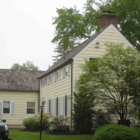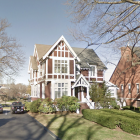
The town’s chief building official last week received a formal letter objecting to the proposed demolition of an approximately 95-year-old house that sits on a widely discussed lot at Weed and Elm Streets. The 10,000-square-foot home at 751 Weed St.—a 3.1-acre parcel where a 120-unit residential development is planned, under a state affordable housing statute—was built by an “an important resident in New Canaan,” according to Mimi Findlay’s letter. Selinger had been president of the New Canaan Historical Society and he “fund-raised to purchase the Hanford Silliman House to provide a new headquarters for the Historical Society and Library space for the books being housed at the Historical Society headquarters in the New Canaan Library,” according to Finidlay’s letter, filed June 14 with Chief Building Official Brian Platz. “Along with Judge Stanley Mead he then studied the buildings around the Church Hill area and proposed a Local Historic District be established there, serving as it first Chairman for several years,” Findlay’s letter continues. “He was followed by Richard Bergmann as Chair and noted in 1979, when the Bergmanns were leaving New Canaan to move to Florida, ‘Because of the excellent persuasive ability of Dick Bergmann, the Red Cross decided not to encase their vintage house in vinyl or aluminum, it Is now being painted.’ The history of the property was reknowned [sic] and respected, although Selinger demolished the existing Victorian residence, which had replaced the original 1781 house of Peter Weed.”
Under Section 12A-9 of the Town Code, if the Town Building Official “receives a pertinent written objection to the application within 15 days following publication of the [demolition] notice, then the Building Official shall promptly refer such objection to the Historical Review Committee.”
It’s unclear whether or when the Committee will take up Findlay’s objection.




